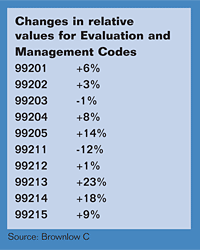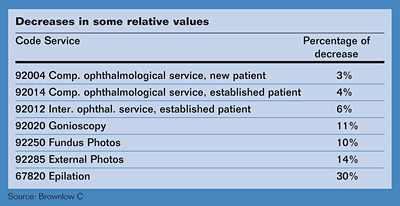No decrease in Medicare reimbursement for this year
Another year, another Medicare controversy over reimbursement for providers. For the fourth year in a row, Medicare has faced its financial crisis and has recommended a significant decrease in fees for services provided to Medicare recipients. For eye doctors, allowed amounts would have been sent downward by an average of between 8% and 9%, although 2006 fees were believed to be nearly 50% below usual and customary fees.
Also for the fourth year in a row, providers’ groups, including the American Optometric Association and American Medical Association, have trekked to Capitol Hill and have pled their case for scrapping Medicare’s ineffective formula for creating fees and have successfully convinced Congress to provide some relief.
For the second straight year, the relief appears in the form of no decrease in the conversion factor, effectively resulting in payments for ODs and OMDs for 2007 about 8% above what they would have been without Congressional action. Another way to look at it, of course, is that the fees for many services will be identical to the reimbursements for last year, and for that matter, 2005, the last year that actually saw an increase.
Conversion factor unchanged, but relative values drop

As expected, Medicare has made additional changes in the relative values for services. With Congress controlling the conversion factor, the only way Medicare can control the allowable payments is to reduce the relative values.
In Medicare’s system, the resource-based relative value system, fees are created by the simple formula: Fee = relative value x conversion factor. As you can see, with only two variables, and with Congress controlling one of them, Medicare can only change the other: relative value. Another way to look at this is “lower relative value multiplied by identical conversion factor equals lower fee.”
The changes in relative values for 2007, compared to the values for 2006, are sweeping and dramatic. The ophthalmological visit codes (92012 to 92014) and refraction were reduced, along with the values for many of the special ophthalmological services, common minor surgical procedures and lacrimal surgical services.
In contrast, relative values and therefore, the fees, for most of the 99000 series office visits and the consult codes increased, as did the values for the three visual fields codes, imaging and extended ophthalmoscopy. Overall, the total of relative value units for about 40 commonly used codes in eye care was 100.45 in 2006 and will be 100.82 for 2007. In spite of that, the decreases in many of the frequently filed codes will certainly be felt by eye doctors across the country.
See specific examples of decreased relative values in the accompanying charts. As always, you’ll have to wait for your Medicare carrier to send out the corrected fee schedule to know the exact allowable amounts for all the covered services. The one you received in October or November included the reduced conversion factor and is therefore not correct.
Changes in reimbursement needed
All players assume that there will eventually have to be some significant changes made in the way Medicare reimburses its providers. Medicare is faced with the old “Too much month left at the end of the money” scenario, with a steady rise in the numbers of services being billed and no way to increase the dollars it has to cover the services. This has resulted in an increase in the number of HMO options for Medicare recipients and also in discussions of new payment methods, such as pay for performance, where providers’ reimbursements would be tied somehow to the efficacy of the care they provide.
No resolution is on the horizon, but you can be sure that Congress and Medicare will leave no stone unturned in their quest to provide maximum care for recipients for minimum expense.

NPIs required by May
In other news, if you have not yet begun the application process for the new National Provider Identifier (NPI), the time has come. All providers must have – and begin to use – NPI numbers by May. These numbers were mandated by HIPAA a few years ago and theoretically will replace all other numbers currently used by payers for identifying providers.
This should be a boon to providers, as each doctor will have only one number to use with all payers, rather than having separate numbers for use with each payer. It also may very well ease the problems with the DEA numbers being illegally used by payers and pharmacies to identify individual providers, as the NPI will fulfill that need for them. The NPI system will be phased into full compliance over the next 2 years or so.
The process of applying for your NPI is quite straightforward and simple. Each provider must apply for a number, which will be used on claims for Medicare in May and with all payers eventually. The doctor will use the same NPI for all claims submitted, even if the claims are submitted by more than one billing entity. Each billing entity (practice, clinic, hospital, etc.) will also apply for an NPI, which will indicate to the payer where the payments should be sent.
In other words, a typical claim will include the doctor’s NPI to indicate who provided the service and who is responsible for the service, and it will also include the clinic’s NPI, to which the payment will be sent.
Application forms and instructions are available through the Web site of the Centers for Medicare and Medicaid Services (CMS), www.cms.hhs.gov/NationalProvIdentStand/. The site offers a direct link to the application process as well as impressive tutorial assistance to aid in the application process. American Optometric Association members can also get additional information and guidance through the AOA Web site: www.AOA.org.
CMS rolls out new 1500 forms
The old CMS 1500 claim form has been the standard in Medicare and for many other payers for 16 years. The format changed effective Jan. 1 and becomes mandatory for all Medicare claims on April 1. In addition, after April 1, any resubmissions of claims originating before that date must be made using the new form, CMS-1500 (08/05.)
The new form is available for your viewing pleasure and downloading and reproduction as an Adobe document through the CMS Web site at www.cms.hhs.gov/cmsforms/downloads/CMS1500805.pdf.
Anyone still submitting claims on paper will need to contact their supplier to be sure the new forms will be available in time for the April 1 deadline.
Vigilance is always critical with Medicare issues
Expect significant changes in Medicare over the next few years, as CMS struggles to keep the program afloat. Primary Care Optometry News will continue to provide updates as information comes available, as will your professional associations, CMS, regional Medicare carriers and other groups. Read all you can and ask questions continuously to be sure you are complying with all Medicare regulations and policy.
For more information:
- Charles B. Brownlow, OD, FAAO, is a member of the Primary Care Optometry News Editorial Board, executive vice president of the Wisconsin Optometric Association and a health care consultant. He can be reached at PMI, LLC, 321 W. Fulton St., PO Box 608, Waupaca, WI 54981; (715) 942-0410; fax: (715) 942-0412; e-mail: Brownlowod@aol.com.
